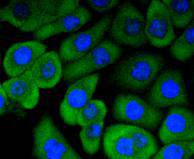Product Name :
RON polyclonal antibody Background :
Receptor protein tyrosine kinases (PTKs) have been classified into different subclasses on the basis of sequence similarity and distinct structural characteristics. The c-Met encoded receptor represents the initial member of one class of receptors characterized by a heterodimeric structure and a cysteine-rich extracellular domain. Ron, also designated macrophage-stimulating protein receptor (MSP receptor), p185-Ron, CD136 antigen or PTK8 represents a second member of this receptor class. The intracellular PTK domains of Ron and Met are highly similar (63% sequence identity) while the extracellular domains are less related (25% sequence identity) and both are rich in cysteine residues. Mature Ron receptor is comprised of a disulfide-linked heterodimer formed from an alpha chain (Ron α) and a beta chain (Ron β). Proteolytic processing results in the separation of the N-terminal Ron α and C-terminal Ron β subunits. Product :
Rabbit IgG, 1mg/ml in PBS with 0.02% sodium azide, 50% glycerol, pH7.2 Storage&Stability :
Store at +4°C after thawing. Aliquot store at -20°C or -80°C. Avoid repeated freeze / thaw cycles. Specificity :
RON polyclonal antibody detects endogenous levels of RON protein. Immunogen :
recombinant protein Conjugate :
Unconjugated Modification :
Unmodification
RON polyclonal antibody Background :
Receptor protein tyrosine kinases (PTKs) have been classified into different subclasses on the basis of sequence similarity and distinct structural characteristics. The c-Met encoded receptor represents the initial member of one class of receptors characterized by a heterodimeric structure and a cysteine-rich extracellular domain. Ron, also designated macrophage-stimulating protein receptor (MSP receptor), p185-Ron, CD136 antigen or PTK8 represents a second member of this receptor class. The intracellular PTK domains of Ron and Met are highly similar (63% sequence identity) while the extracellular domains are less related (25% sequence identity) and both are rich in cysteine residues. Mature Ron receptor is comprised of a disulfide-linked heterodimer formed from an alpha chain (Ron α) and a beta chain (Ron β). Proteolytic processing results in the separation of the N-terminal Ron α and C-terminal Ron β subunits. Product :
Rabbit IgG, 1mg/ml in PBS with 0.02% sodium azide, 50% glycerol, pH7.2 Storage&Stability :
Store at +4°C after thawing. Aliquot store at -20°C or -80°C. Avoid repeated freeze / thaw cycles. Specificity :
RON polyclonal antibody detects endogenous levels of RON protein. Immunogen :
recombinant protein Conjugate :
Unconjugated Modification :
Unmodification
-
 ICC staining RON in A549 cells (green). The nuclear counter stain is DAPI (blue). Cells were fixed in paraformaldehyde, permeabilised with 0.25% Triton X100/PBS.
ICC staining RON in A549 cells (green). The nuclear counter stain is DAPI (blue). Cells were fixed in paraformaldehyde, permeabilised with 0.25% Triton X100/PBS. -
 ICC staining RON in AGS cells (green). The nuclear counter stain is DAPI (blue). Cells were fixed in paraformaldehyde, permeabilised with 0.25% Triton X100/PBS.
ICC staining RON in AGS cells (green). The nuclear counter stain is DAPI (blue). Cells were fixed in paraformaldehyde, permeabilised with 0.25% Triton X100/PBS.
Bioworld Biotech only provide peptides for our antibodies and do not provide additional peptide customization services.
Price/Size :
USD 368/1mg/vial
Tips:
For phospho antibody, we provide phospho peptide(0.5mg) and non-phospho peptide(0.5mg).Describe :
Blocking peptides are peptides that bind specifically to the target antibody and block antibody binding. These peptide usually contains the epitope recognized by the antibody. Antibodies bound to the blocking peptide no longer bind to the epitope on the target protein. This mechanism is useful when non-specific binding is an issue, for example, in Western blotting (WB) and Immunohistochemistry (IHC). By comparing the staining from the blocked antibody versus the antibody alone, one can see which staining is specific; Specific binding will be absent from the western blot or IHC performed with the neutralized antibody.Formula:
Synthetic peptide was lyophilized with 100% acetonitrile and is supplied as a powder. Reconstitute with 0.1 ml DI water for a final concentration of 10 mg/ml.The purity is >90%,tested by HPLC and MS.
Storage:
The freeze-dried powder is more stable. For short time at 2-8°C. For long term storage store at -20°C.
Note :
This product is for research use only (RUO only). Not for use in diagnostic or therapeutic procedures.
 RON polyclonal antibody
RON polyclonal antibody  Datasheet
Datasheet COA
COA MSDS
MSDS SHIP
SHIP